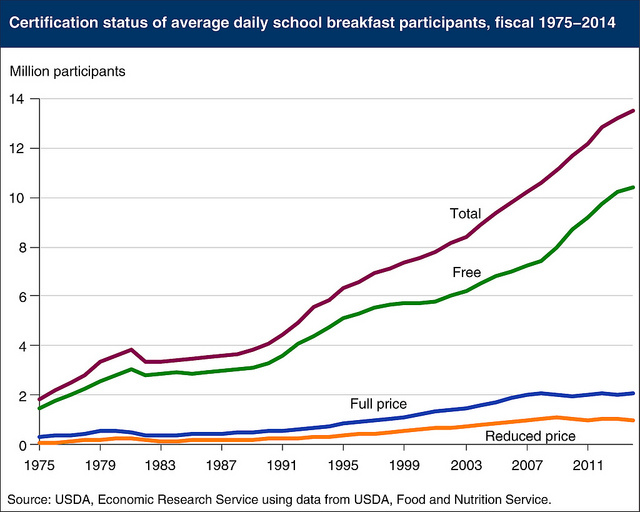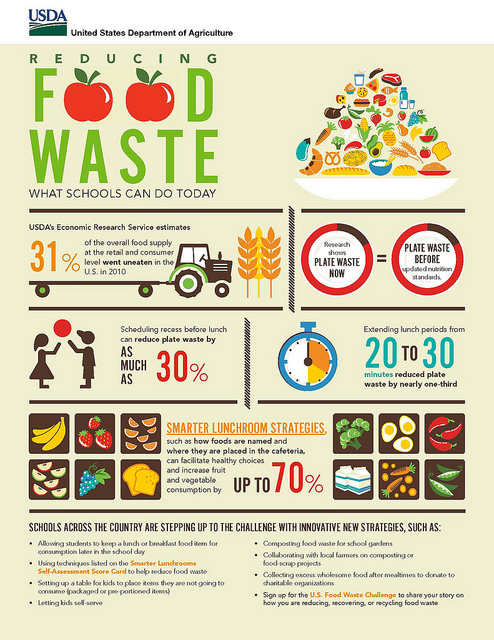Having trouble viewing this email? View it as a Web page.

Building a Better Future for Our Children
ICYMI, here's what happened last week at USDA:
When it comes to our kids’ health, we know that proper nutrition is critical to putting them on a path to success. Kids go to the doctor less, pay better attention in the classroom and perform better overall with access to well-rounded meals for breakfast, lunch and dinner. And as kids head back to school, USDA is here to help parents, school districts and school nutrition professionals ensure that over 30 million kids are getting healthier meals every day in the school cafeteria.
Last week the Centers for Disease Control and Prevention (CDC) published a new study showing some of the positive changes to school meals. The study found a significant increase in schools offering two or more fruits and vegetables a day as well as reducing sodium in the meals they serve. It also showed that almost all schools are offering whole grains each day for breakfast (97.2%) and lunch (94.4%).
We also partnered with the Center for Science in the Public Interest (CSPI) and Mom’s Rising for a #FoodFri Twitter chat where we disseminated helpful information, tips and statistics to an engaged and very enthusiastic audience. You can see the conversation here.
Tune in next week as we turn our focus to preserving our Nation’s water soil and lands, but please be sure to keep the healthy meals conversation going using #HealthierNextGen.
The Week in Pictures
If you bring your lunch, here are some safe handling tips to prevent foodborne illness.
Our nation’s schools play an important role in reducing food waste.
All images available in Flickr.
On the USDA Blog
School Lunch Equipment Grants Help Provide Healthier Meals to Students Nationwide
USDA supports our tireless school nutrition professionals as they work to provide kids the nutrition they need to learn and develop into healthy adults. To further assist schools, USDA announced the availability of $25 million in National School Lunch Program (NSLP) equipment grants for Fiscal Year 2015. These grants help schools obtain much needed infrastructure to better serve nutritious meals, support food safety efforts, improve energy efficiency, and expand participation in school nutrition programs.
What’s Shaking in School Meals?
What’s shaking in USDA’s school meals programs? Delicious and nutritious food, that’s what! Healthy food does not have to be bland or boring. There’s more to creating a tasty meal than just dousing food in dressing or layering on salty sauces. It’s easy to make your dish pop without adding excess sodium. Many schools around the country have figured out creative ways to serve low-sodium meals that maximize taste. So what can you do this school year to “spice” things up and take school meals to the next level?
Keeping Foods Safe For a Successful School Year
As the days get shorter and the month of August winds down with the appearance of back-to-school sales, we recognize the telltale signs that signal the “official” end of summer and the beginning of a new school year. For USDA professionals interested in food safety, nutrition and health, thoughts of safe food preparation and school lunches packed at home, come to mind. By remembering four key principles to assure safety – Clean, Separate, Cook and Chill – many foodborne illnesses can be prevented.
School Breakfast Program Provides Increasing Number of Meals
Sometimes called the “most important meal of the day” for school-aged children, breakfast is available at nearly 90,000 schools across the country courtesy of USDA’s School Breakfast Program. On an average school day in fiscal 2014, some 13.5 million students participated. The Economic Research Service (ERS) illustrates the growth of the program in a new entry in its popular daily “Charts of Note” series. As the chart indicates, participation has more than doubled since 1996.
“Fuel Up to Play 60″ Has Game Plan to Supercharge School Fitness and Nutrition
Meet Jack, a sixth-grader who is eager to become a school nutrition and fitness game changer. He is one of nearly 20,000 student ambassadors with Fuel Up to Play 60 (FUTP 60), a program launched by the National Dairy Council (NDC) and National Football League (NFL) in collaboration with USDA. FUTP 60 empowers youth like Jack to improve nutrition and physical activity at their schools and in their communities. Jack serves as student ambassador for his home state of Delaware.
Taking Note of Paper’s Popularity
Kindle, iPad, and Surface—oh my! It’s fascinating to think about the increasing number of electronic tablets in the marketplace. However, a recent survey suggests that students and educators alike grab another notepad when it comes to comprehending what they’ve read. And that notepad is made of paper. In fact, 74 percent of college educators surveyed in the 2015 Annual Back to School Report said that their students are more likely to stay focused when they are using a notebook and textbook rather than a laptop.
Student Climate and Conservation Congress: Bright Young Minds
This year, for the first time, the Forest Service partnered with the Green School Alliance and their principle partner the Fish and Wildlife Service (FWS) in support of the Student Climate and Conservation Congress (Sc3). Held June 21-27 on the beautiful campus of the FWS’s National Conservation Training Center in Shepherdstown, West Virginia. Sc3 brought together more than 100 creative, innovative and dedicated high school students from across the country. While there were adults present if needed, Sc3 was a youth driven congress. Their big quest “To change everything, we need everybody. How will you engage others in developing a brighter and more just global community?”
Alaskan High School Students Learn Valuable Skills at “Fish Boot Camp”
“The thing that our forests grow best is salmon!” is the local phrase that a visitor is most likely to hear when visiting some of the 32 communities that live near the Tongass National Forest of Southeast Alaska. Tongass National Forest staff, local school districts, a local conservation organization, and the University of Alaska have undertaken a joint project to figure out how a forest can be managed to create jobs and other economic opportunities and guarantee the long-term sustainable yield of the Tongass’ fisheries resources.
USDA TV
Week in Review: A weekly look at some of the events and activities at the U.S. Department of Agriculture. In this edition of USDA Week In Review: Beef and egg up; pork down, and Women's Equality Day
Read about us in the News
School Lunches Becoming Healthier, Statistics Indicate (New York Times)
The humble school lunch, that staple of most every American child’s diet, has become healthier. That was the conclusion of a federal report released Thursday that showed that the nutritional profile of school meals in the United States had improved substantially since higher government standards went into effect in 2012. Nearly 80 percent of schools offered two or more vegetables per meal in 2014, the data showed, up from 62 percent in 2000. Two or more fruits were offered in about 78 percent of schools, up from 68 percent in 2000. About a third of schools now have salad bars.
USDA Head Tom Vilsack Encourages Kids to Fuel Up With Healthy Foods (Kids SI)
The ballplayer amazes. The sprinter confounds. How is it, one wonders, that these athletes have surged to such low times and high heights? What is it about them that makes this possible? There is no single answer. Genes matter, as does practice. But there is another major factor that determines one’s fitness level: diet. “It’s extremely important,” Secretary of Agriculture Tom Vilsack said in a recent interview. “The ability to have proper nutrition…will ensure youngsters start life in a much better circumstance.”
Not your parents' school lunch — burrito bar, anyone? (LA Times)
School cafeterias have not generally been known for their memorable meals — at least not in a good way. Many evoke memories of surly lunch ladies dishing up Sloppy Joe sandwiches made out of "mystery meat" to unwitting pupils. In an effort to burst that stereotype, La Cañada Unified School District officials have hired a new vendor that is focusing on providing fresher, more healthful meals and giving students more leeway to build their own creations. So far, officials said, the burrito bar seems to be a hit.
CDC gives schools good grades for nutrition, but asks: Where are the salad bars? (LA Times)
Federal health authorities give American schools good grades for improving the nutritional quality of food served in their cafeterias — but there's still room for improvement, they said. A report released Thursday by the Centers for Disease Control and Prevention found that 79% of schools served at least two kinds of non-fried vegetables and 78% sold at least two kinds of fruits (including 100% fruit juice) each day for lunch.
Editorial: Keep healthy lunches on school menus (Kansas City Star)
Obama administration officials are trying to get Congress to endorse fruits, vegetables, whole grains and other healthier food options for school cafeteria breakfasts and lunches for kids. At stake is the reauthorization of the 2010 Healthy Hunger Free Kids Act, which mandates better nutritional standards. But time is running out. The law that has made meals at schools healthier for millions of students expires Sept. 30. Agriculture Secretary Tom Vilsack told The Star on Tuesday that the law is working.
Commentary: Healthy school meal standards are working in Ky. and we must uphold them (Kentucky Forward)
It’s not often that a retired Army general and a middle school teacher share a stage. But there we were in July at Southern Middle School because we share a passion: healthier school foods. Southern Middle School is the perfect place to talk about changes that are happening to school foods and drinks, because we’ve been working for years to make sure students and staff have healthier options throughout the day.
Vilsack to call on Congress to reauthorize Healthy Hunger-Free Kids Act (Politico 8/25)
Agriculture Secretary Tom Vilsack will call on Congress to reauthorize child nutrition programs when he outlines the Obama administration's strategy for battling nutrition and poverty, Sept. 8, at the National Press Club, according to a press release issued today. The secretary will be joined by Sandra Hassink, president of the American Academy of Pediatrics, and Jessica Donze Black, director of child nutrition at the Pew Charitable Trusts. Each will give remarks and then take questions from reporters. The announcement touts the Healthy Hunger-Free Kids Act as "a key component" of the Obama administration's strategy to improve nutrition for millions of children.
Tom Vilsack and Arne Duncan: Hunger doesn’t take a vacation (Harlan Daily Herald)
One of the most powerful things we can do to build a brighter future for America’s kids is to give them the nutrition they need to learn and grow. Thanks to the Healthy, Hunger-Free Kids of 2010, nearly 31 million kids are now guaranteed healthy breakfasts and lunches at school. For many kids, these are the most nutritious meals they’ll get all day — but what happens when school lets out? Proper nutrition is critical for a child’s ability to learn, grow, and be ready to achieve their dreams — and hunger is one of the most severe roadblocks to the learning process.
Steven Abrams: Why We Must Protect Healthy Dietary Guidelines from Political Interference (Huffington Post)
There are few tasks more important in creating a healthy community across the United States than creating environments in which all of us, especially children, have healthy diets and plenty of opportunity to exercise. Yet a recent U.S. government report that clearly outlines steps to achieve this goal is being subject to political scrutiny and an attempt to stop its implementation. Why? Because the food lobby does not like it. It is time to stand up for science and evidence-based guidelines to help stop obesity and poor health in our population, especially in our children.
Strengthening Child Nutrition Programs: Back to School and Back to Work for Congress (Center for American Progress 8/25)
From inner cities to rural farmlands, children are returning to school to learn and grow—but for thousands of hungry children nationwide, learning is difficult or impossible. When Congress returns from its August recess, the House and Senate will debate the reauthorization of many of the country's most critical programs that provide meals and nutritional support to children—including school breakfasts and lunches, summer meals, and the Special Supplemental Nutrition Program for Women, Infants, and Children, or WIC.
Editorial: Why we need to keep U.S. school lunches healthy (Dallas Morning News)
Dallas ISD has been a leader in the area of good, healthy school lunches for some time. Many of us came of age in the time of mystery meat and succotash surprise in the cafeteria line at school. School lunches didn’t make us fat, because they often went from the tray to the trash with little more than a stifled gag reflex in between. That time gave way to the age of the french fry and the vending machine in the cafeteria. Pizza Fridays became pizza every day. And if kids washed it all down with a can of soda, well, at least they were eating their lunch. Is it any surprise, though, that this age went hand and hand with a soaring obesity rate that is hurting our children and, really, hurting us as a country?
Listen
CONNECTING SEAFOOD CONSUMPTION AND HEALTH BENEFITS
Broadcast Date: Tuesday, August 25, 2015
Seafood, including fish with omega-3 fatty acids, can offer health benefits, yet Americans do not eat as much seafood as they should. Rod Bain reports. PARTICIPANTS: Rod Bain and Susan Raatz ("Rawtz") of the Grand Forks Human Nutrition Research Center
A RENEWED PUSH FOR A NEW WAY TO PAY FOR FIGHTING WILDFIRES
Broadcast Date:Fri, August 28, 2015
Once again the Forest Service is having to take money from other activities to pay the skyrocketing costs of fighting this season's wildfires. (Gary Crawford, Ag. Secy' Tom Vilsack and Senator Ron Wyden)
KATRINA - TEN YEARS LATER
Broadcast Date: Fri, August 28, 2015
A decade after Hurricane Katrina hit the Gulf Coast and New Orleans, there is celebration of the continued recovery and rebuilding in the aftermath. (Rod Bain and President Barack Obama)
CONSIDER GOAT AS THE ENTREE FOR YOUR MEAL
Broadcast Date: Wed, August 26, 2015
Some Americans are trying goat as a meat source, and learning about its nutritional value and preparation methods. (Rod Bain and David Fernandez of University of Arkansas Extension)
Share
Smarter lunchroom strategies decrease plate waste & increase healthy food consumption by up to 70%. #HealthierNextGen pic.twitter.com/2Fm8WvNzs8
— Dept. of Agriculture (@USDA) August 27, 2015
Keeping foods safe for a successful school year http://t.co/AkX6YPkUmn #HealthierNextGen pic.twitter.com/rGAfLdy6G0
— Dept. of Agriculture (@USDA) August 28, 2015
A1. Thx to new meal standards 95%+ of schools now serve meals promoting better nutrition & reducing obesity #FoodFri pic.twitter.com/t75k1Z747c
— Dept. of Agriculture (@USDA) August 28, 2015
Healthy food doesn’t have to be bland or boring. We've got some tips for meals that are lower in sodium. #FoodFri pic.twitter.com/r2fd9fPuWh
— Dept. of Agriculture (@USDA) August 28, 2015
#FoodFri A1: Schools are offering whole grains and more fruits & vegetables. @CDCMMWR study: http://t.co/4wzZF1oV7N pic.twitter.com/8RfnihyACI
— APHA (@PublicHealth) August 28, 2015
A2: Kids are on board! This @HarvardChanSPH study found fruit & veg consumption went up after new standards: http://t.co/vTfWsbeg4R #FoodFri
— Farm to School (@FarmtoSchool) August 28, 2015




